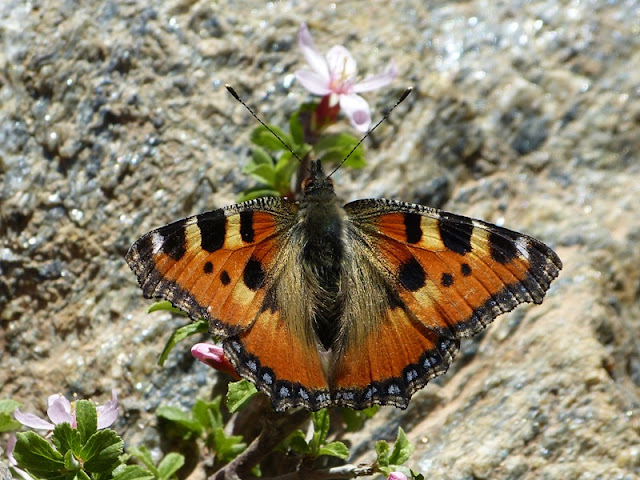There is a meadow is just off the road at about 2,000 metres above sea level that I always visit when I go to the Sierra Nevada. It has a little stream running through it, which I expect is quite ferocious during the snow melt, but is mostly dry in the summer months. It is such an amazing spot, as there are so many butterflies in quite a small area. Again, the butterflies I saw this June were quite different from what I am used to seeing in July. There were far fewer, but they were lovely nonetheless.
Almost immediately a beautiful Knapweed Fritillary landed on a shrub in front of me. I think there must have been about ten of them in this area.
A few Iberian Scarce Swallowtails kept flying across the meadow and there must have been more than 40 Clouded Yellows.
All along the dried up stream bed there were little Lorquin’s Blues.
Despite their size they were quite aggressive, chasing off any other butterflies that dared to land too close! Here is one about to attack a Common Blue!
I normally see a lot of Marsh Fritillaries at this spot, but this year I only saw one. I also saw eight or ten Small Heaths. These had me a bit confused at first as some of them appeared to have some metallic scales on their wings.
The Queen of Spain Fritillaries here were a lot fresher than those higher up the mountains.
I was pleased to see some Common Blues, Polyommatus icarus, here. In most of Southern Spain they are replaced by the identical-looking Southern Blue, Polyommatus celina, but the Common Blue occurs in the Sierra Nevada, having been left behind as the climate warmed after the last Ice Age.
I spotted another little butterfly that I was surprised to see was a Green Hairstreak. I think I saw three different individuals. I have never seen these in the Sierra Nevada before and expected that they would occur earlier in the year.
Making up the numbers were Small Whites, Painted Ladies and Meadow Browns.
There were some Western Dappled Whites amongst them.
I also saw a Southern Marbled Skipper.
And I had a lovely view of what I thought was a Spotted Fritillary. It wasn’t until I checked my pictures back home that I realised it was a Lesser Spotted Fritillary, Melitaea trivia, – a species I hadn’t seen before.
In each of my three previous visits to the Sierra Nevada, always in July, I have seen over 40 species of butterflies. This year, with it being earlier in the year I saw 23 species. I didn’t feel disappointed in the slightest. It would have been nice to have seen some of the rarer species higher up the mountains, but this delightful meadow was so lovely and it made up for the lack of variety I had seen earlier in the day.









































